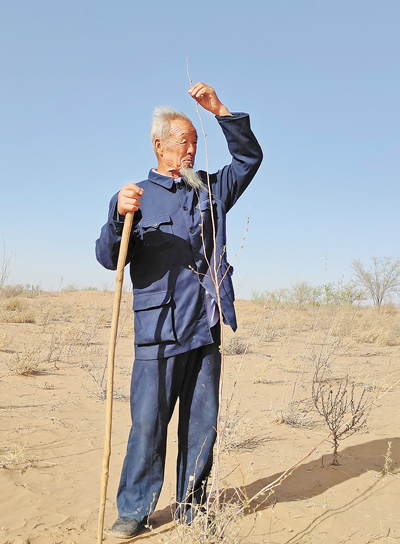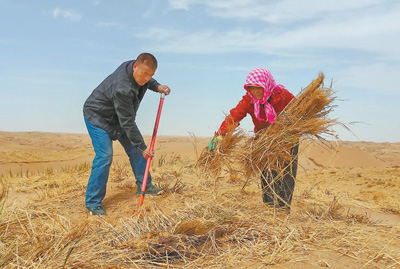




- BRNN
- BRI News
- BRNN News
- Database
Official Documents Polices and Regulations
Inter-government Documents International Cooperation BRI Countries
Business Guide Economic Data BRI Data
Trade
Investment Projects Latest projects
Cases - Content Pool
In Hongshui village, Changcheng town, Liangzhou district, Wuwei city, northwest China's Gansu Province, on the southern edge of the Tengger Desert, a gust of north wind sways the straw grids on the sand dunes. Some of the squares contain what look like a few dry twigs, thinner than chopsticks and barely longer than a palm.
"They've sprouted!" Wang Yinji smiles clumsily at his wife, Jin Yuxiu. The couple lie on the sandy slope, carefully digging away the top layer of sand with their hands around the tiny twigs. About 10 centimeters down, they find sesame-sized green shoots poking through the sand.
Wang Tianchang, Wang Yinji's 82-year-old father, beams when he hears the news: "All our suffering wasn't in vain!"

Wang Tianchang checks on the growth of a tree sapling at the southern edge of the Tengger Desert in Hongshui village, Changcheng town, Liangzhou district, Wuwei city, northwest China's Gansu Province. (People's Daily/Song Chao jun)
In fact, the family has been "suffering" for 26 years. Since 1999, Wang Tianchang, along with his wife, son, and daughter-in-law, moved into the desert to plant trees and combat desertification. They have made straw checkerboard sand barriers that stabilize 10,000 mu (666.67 hectares) of sandy land. Their faces have darkened, their skin roughened, but the drifting sands have been locked down by straw grids, and patches of green have taken root.
In the early 1990s, the family moved to a part of the village with more arable land, but later discovered that frequent sandstorms often buried their fields.
At that time, the first generation of sand control workers at the Babusha Forest Farm in Gulang county, Wuwei city had already spent over a decade exploring desertification control methods. Inspired by their efforts, Wang Tianchang instructed his son, Wang Yinji, to ride a motorcycle to the county and bring back sacks of seeds. They began by cultivating seedlings on their own farmland.
After two to three years of experimentation, seeds of Chinese tamarisks and sacsaoul trees finally began to grow into seedlings. On the 16th day of the first lunar month in 1999, braving biting winds, Wang Tianchang and his wife, Li Lanying, ventured into the desert with bundles of wheat straws, marking the beginning of their extraordinary journey in combating desertification.
They started by making straw checkerboard sand barriers. That spring, after sowing wheat at home, Wang Yinji quickly joined his parents in the desert to plant saplings.

Wang Yinji and his wife place straw checkerboard sand barriers at the southern edge of the Tengger Desert in Hongshui village, Changcheng town, Liangzhou district, Wuwei city, northwest China's Gansu Province. (People's Daily/Song Chaojun)
However, these saplings proved difficult to nurture. Sometimes trees planted during the day were uprooted by sandstorms overnight. At other times seedlings that had survived initially would perish after several days of extreme heat.
Determined to stay to check on the growth of saplings, Wang Tianchang decided to dig an underground dugout near their tent. He worked side by side with his son to create a more permanent shelter.
Through over more than two decades of hard work, they accumulated considerable experience, continuously refining their tools and methods.
From seedling cultivation to planting techniques, the Wang family's expertise has steadily improved, with survival rates for newly planted trees now exceeding 85 percent.
The story of the Wang family's tree-planting efforts has spread beyond the desert. In 2006, the local labor union provided funding and cement to build a four-room house for them. Two years later, the local forestry and grassland bureau constructed a watchtower nearby.
In 2013, the family was officially hired as forest rangers, receiving subsidies for maintaining public welfare forests. Electricity was connected to their house, enabling easier water pumping from their cistern. An adjacent asphalt road facilitated the transportation of supplies.
Support from across society has continued to grow. Some people donate money and materials, while many come in person to participate in tree-planting activities. Sand control workers, including Guo Wangang and Guo Xi from the Babusha Forest Farm, regularly donate seeds and saplings.
With strong backing from local authorities, the tree-planting initiative has gained significant momentum. Wuwei city has vigorously implemented the Three-North Shelterbelt Forest Program, restoring 9.84 million mu of desertified land and creating a greener, more vibrant ecological environment. Liangzhou district alone has rehabilitated 1.96 million mu of desertified land.
Wang Zhirong, the eldest grandson of Wang Tianchang, currently works in Xinjiang. Every year, he sends 30,000 yuan ($4,165.22) home – funds earmarked specifically for desertification control efforts.
To date, the family has planted over 7.95 million sand-resistant plants, with funding primarily coming from grain farming savings, government subsidies, and charitable donations.
"We will continue to pass down the mission of desertification control to future generations," Wang Yinji said.

Tel:86-10-65363107, 86-10-65368220, 86-10-65363106